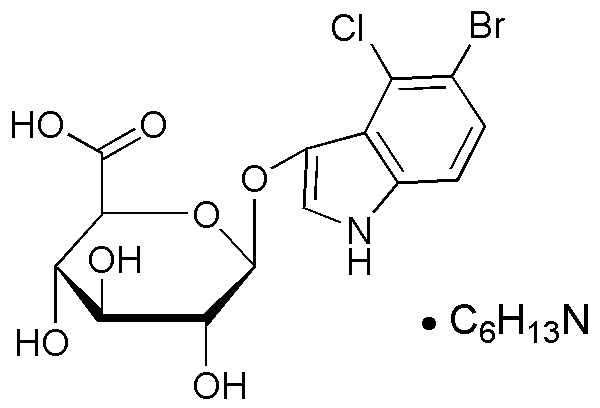5-Bromo-4-chloro-3-indolyl-b-D-glucuronide cyclohexylammonium salt is widely utilized in research focused on:
- Biochemical Assays: This compound is used as a substrate in enzyme assays, particularly for measuring the activity of β-glucuronidase, which is important in drug metabolism studies.
- Histochemical Staining: It serves as a chromogenic substrate for visualizing enzyme activity in tissue samples, aiding researchers in understanding cellular processes and disease mechanisms.
- Drug Development: The compound plays a role in pharmacological research, helping scientists evaluate the efficacy and safety of new drugs by monitoring metabolic pathways.
- Environmental Studies: It is applied in studies assessing the biodegradation of pharmaceuticals in wastewater, providing insights into environmental impacts and remediation strategies.
- Genetic Research: The compound is utilized in the study of gene expression, allowing researchers to track the activity of specific genes in various biological contexts.
General Information
Properties
Safety and Regulations
Applications
5-Bromo-4-chloro-3-indolyl-b-D-glucuronide cyclohexylammonium salt is widely utilized in research focused on:
- Biochemical Assays: This compound is used as a substrate in enzyme assays, particularly for measuring the activity of β-glucuronidase, which is important in drug metabolism studies.
- Histochemical Staining: It serves as a chromogenic substrate for visualizing enzyme activity in tissue samples, aiding researchers in understanding cellular processes and disease mechanisms.
- Drug Development: The compound plays a role in pharmacological research, helping scientists evaluate the efficacy and safety of new drugs by monitoring metabolic pathways.
- Environmental Studies: It is applied in studies assessing the biodegradation of pharmaceuticals in wastewater, providing insights into environmental impacts and remediation strategies.
- Genetic Research: The compound is utilized in the study of gene expression, allowing researchers to track the activity of specific genes in various biological contexts.
Documents
Safety Data Sheets (SDS)
The SDS provides comprehensive safety information on handling, storage, and disposal of the product.
Product Specification (PS)
The PS provides a comprehensive breakdown of the product’s properties, including chemical composition, physical state, purity, and storage requirements. It also details acceptable quality ranges and the product's intended applications.
Certificates of Analysis (COA)
Search for Certificates of Analysis (COA) by entering the products Lot Number. Lot and Batch Numbers can be found on a product’s label following the words ‘Lot’ or ‘Batch’.
Número de catálogo
Número de lote/lote
Certificates Of Origin (COO)
This COO confirms the country where the product was manufactured, and also details the materials and components used in it and whether it is derived from natural, synthetic, or other specific sources. This certificate may be required for customs, trade, and regulatory compliance.
Número de catálogo
Número de lote/lote
Safety Data Sheets (SDS)
The SDS provides comprehensive safety information on handling, storage, and disposal of the product.
DownloadProduct Specification (PS)
The PS provides a comprehensive breakdown of the product’s properties, including chemical composition, physical state, purity, and storage requirements. It also details acceptable quality ranges and the product's intended applications.
DownloadCertificates of Analysis (COA)
Search for Certificates of Analysis (COA) by entering the products Lot Number. Lot and Batch Numbers can be found on a product’s label following the words ‘Lot’ or ‘Batch’.
Número de catálogo
Número de lote/lote
Certificates Of Origin (COO)
This COO confirms the country where the product was manufactured, and also details the materials and components used in it and whether it is derived from natural, synthetic, or other specific sources. This certificate may be required for customs, trade, and regulatory compliance.


